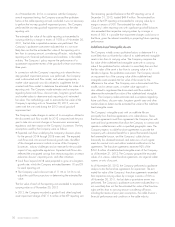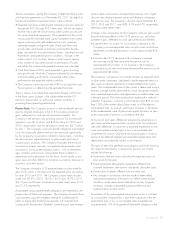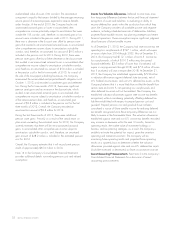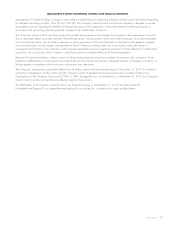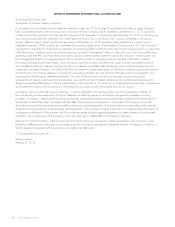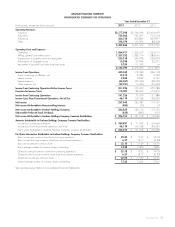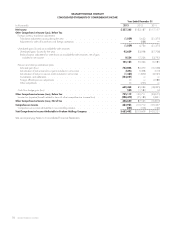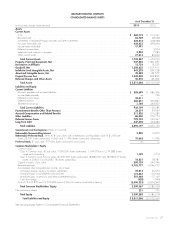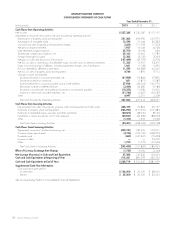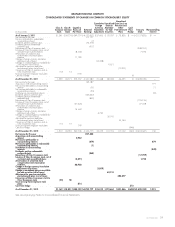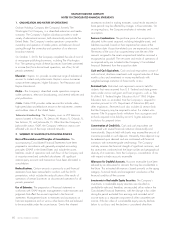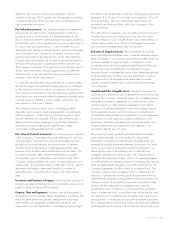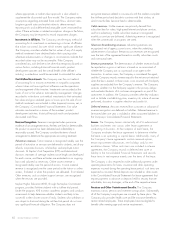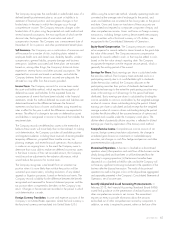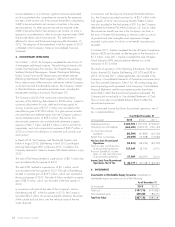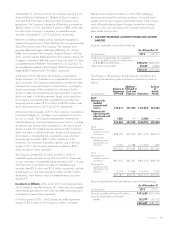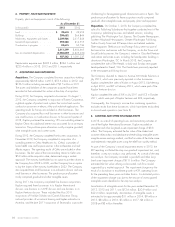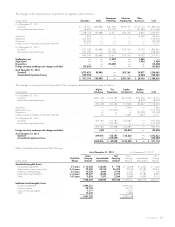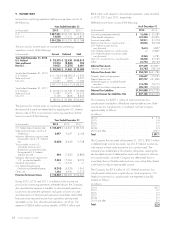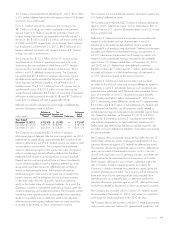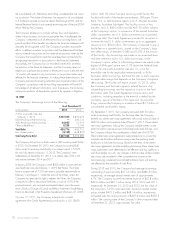Washington Post 2013 Annual Report Download - page 78
Download and view the complete annual report
Please find page 78 of the 2013 Washington Post annual report below. You can navigate through the pages in the report by either clicking on the pages listed below, or by using the keyword search tool below to find specific information within the annual report.GRAHAM HOLDINGS COMPANY
NOTES TO CONSOLIDATED FINANCIAL STATEMENTS
1. ORGANIZATION AND NATURE OF OPERATIONS
Graham Holdings Company (the Company), formerly The
Washington Post Company, is a diversified education and media
company. The Company’s Kaplan subsidiary provides a wide
variety of educational services, both domestically and outside the
United States. The Company’s media operations comprise the
ownership and operation of cable systems and television broad-
casting (through the ownership and operation of six television
broadcast stations).
On October 1, 2013, the Company completed the sale of most of
its newspaper publishing businesses, including The Washington
Post. The operating results of these businesses have been presented
in income (loss) from discontinued operations, net of tax, for all
periods presented.
Education—Kaplan, Inc. provides an extensive range of educational
services for students and professionals. Kaplan’s various businesses
comprise three categories: Higher Education, Test Preparation and
Kaplan International.
Media—The Company’s diversified media operations comprise
cable operations, television broadcasting, and several websites and
print publications.
Cable. Cable ONE provides cable services that include video,
high-speed data and telephone service in the midwestern, western
and southern states of the United States.
Television broadcasting. The Company owns six VHF television
stations located in Houston, TX; Detroit, MI; Miami, FL; Orlando, FL;
San Antonio, TX; and Jacksonville, FL. Other than the Company’s
Jacksonville station, WJXT, the Company’s television stations are
affiliated with one of the major national networks.
2. SUMMARY OF SIGNIFICANT ACCOUNTING POLICIES
Basis of Presentation and Principles of Consolidation. The
accompanying Consolidated Financial Statements have been
prepared in accordance with generally accepted accounting
principles (GAAP) in the United States and include the assets,
liabilities, results of operations and cash flows of the Company and
its majority-owned and controlled subsidiaries. All significant
intercompany accounts and transactions have been eliminated in
consolidation.
Reclassifications. Certain amounts in previously issued financial
statements have been reclassified to conform with the 2013
presentation, which includes the reclassification of the results of
operations of certain businesses as discontinued operations for all
periods presented.
Use of Estimates. The preparation of financial statements in
conformity with GAAP requires management to make estimates and
judgments that affect the amounts reported in the financial
statements. Management bases its estimates and assumptions on
historical experience and on various other factors that are believed
to be reasonable under the circumstances. Due to the inherent
uncertainty involved in making estimates, actual results reported in
future periods may be affected by changes in those estimates. On
an ongoing basis, the Company evaluates its estimates and
assumptions.
Business Combinations. The purchase price of an acquisition is
allocated to the assets acquired, including intangible assets, and
liabilities assumed, based on their respective fair values at the
acquisition date. Acquisition-related costs are expensed as incurred.
The excess of the cost of an acquired entity over the net of the
amounts assigned to the assets acquired and liabilities assumed is
recognized as goodwill. The net assets and results of operations of
an acquired entity are included in the Company’s Consolidated
Financial Statements from the acquisition date.
Cash and Cash Equivalents. Cash and cash equivalents consist of
cash on hand, short-term investments with original maturities of three
months or less and investments in money market funds with
weighted average maturities of three months or less.
Restricted Cash. Restricted cash represents amounts held for
students that were received from U.S. Federal and state govern-
ments under various aid grant and loan programs, such as Title
IV of the U.S. Federal Higher Education Act of 1965 (Higher
Education Act), as amended, that the Company is required to
maintain pursuant to U.S. Department of Education (ED) and
other regulations. Restricted cash also includes (i) certain funds
that the Company may be required to return if a student who
receives Title IV program funds withdraws from a program and
(ii) funds required to be held by non-U.S. higher education
institutions for prepaid tuition.
Concentration of Credit Risk. Cash and cash equivalents are
maintained with several financial institutions domestically and
internationally. Deposits held with banks may exceed the amount of
insurance provided on such deposits. Generally, these deposits may
be redeemed upon demand and are maintained with financial
institutions with investment-grade credit ratings. The Company
routinely assesses the financial strength of significant customers, and
this assessment, combined with the large number and geographical
diversity of its customers, limits the Company’s concentration of risk
with respect to trade accounts receivable.
Allowance for Doubtful Accounts. Accounts receivable have been
reduced by an allowance for amounts that may be uncollectible in
the future. This estimated allowance is based primarily on the aging
category, historical trends and management’s evaluation of the
financial condition of the customer.
Investments in Marketable Equity Securities. The Company’s
investments in marketable equity securities are classified as
available-for-sale and, therefore, are recorded at fair value in the
Consolidated Financial Statements, with the change in fair value
during the period excluded from earnings and recorded net of
income taxes as a separate component of other comprehensive
income. If the fair value of a marketable equity security declines
below its cost basis and the decline is considered other than
60 GRAHAM HOLDINGS COMPANY


